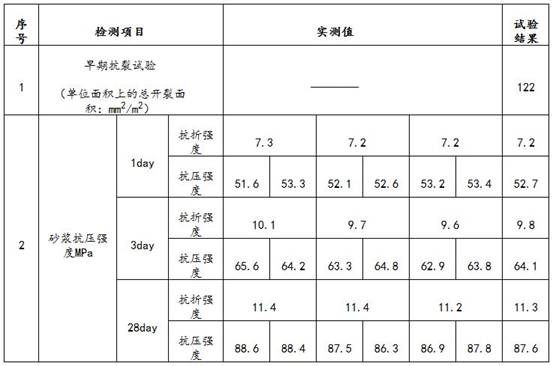A cement mortar dry mixture for rapid maintenance of cement pavement
A technology of cement mortar and dry mixing, which is applied in the field of construction, can solve the problems of loss of interlayer connection in dry film formation, difficulty in mastering the process, and increase of interface cohesion, so as to facilitate national economic activities and shorten the maintenance period. It takes time to increase the effect of interfacial adhesion
- Summary
- Abstract
- Description
- Claims
- Application Information
AI Technical Summary
Problems solved by technology
Method used
Image
Examples
Embodiment 1
[0026] The cement mortar dry mixture used for rapid maintenance of cement pavement provided in this embodiment is composed of 377 to 435 parts of Portland cement (where calcium silicate-based Portland cement is cooked) in parts by weight. Limestone or granulated blast furnace slag with less than 5% limestone or granulated blast furnace slag, and a hydraulic cementitious material made by grinding an appropriate amount of gypsum, collectively referred to as Portland cement, also collectively referred to as Portland cement internationally), 547-623 grading (Gradation is the distribution of particle sizes at all levels of aggregate, which can be determined by sieve analysis test) River sand, 35-60 parts of stone powder, 27-32 parts of silica fume, 10.6-12 parts of fly ash (which is obtained from coal The fine ash collected from the flue gas after combustion is generally the main solid waste discharged from coal-fired power plants), 0.1 to 2 parts of calcium formate (also known as c...
Embodiment 2
[0054] This example provides a formula for the further preferred component dosage of the cement mortar dry mixture described in Example 1, that is: in parts by weight, it consists of 383-428 parts of Portland cement, 556-610 parts Graded river sand, 38-56 parts of stone powder, 27.5-31 parts of silicon powder, 10.9-11.8 parts of fly ash, 0.3-1.6 parts of calcium formate, 0.8-5.0 parts of triisopropanolamine, 1.3-2.7 parts of α- It is composed of sodium alkenyl sulfonate, 0.9-1.9 parts of polyvinyl alcohol and 1.5-2.4 parts of anhydrous calcium chloride.
[0055] The technical effect of this embodiment can be directly derived based on the beneficial effect of Embodiment 1, and will not be repeated here.
Embodiment 3
[0057] This example provides a formula for the further preferred component dosage of the cement mortar dry mixture described in Example 2, that is: in parts by weight, it consists of 394-420 parts of Portland cement, 570-598 parts Graded river sand, 45-52 parts of stone powder, 28-31 parts of silicon powder, 11-11.5 parts of fly ash, 0.4-1.2 parts of calcium formate, 1.8-4.4 parts of triisopropanolamine, 1.6-2.5 parts of α- It is composed of sodium alkenyl sulfonate, 1.0-1.7 parts of polyvinyl alcohol and 1.7-2.3 parts of anhydrous calcium chloride.
[0058] The technical effect of this embodiment can be directly derived based on the beneficial effect of Embodiment 1, and will not be repeated here.
PUM
| Property | Measurement | Unit |
|---|---|---|
| particle diameter | aaaaa | aaaaa |
| particle diameter | aaaaa | aaaaa |
| particle diameter | aaaaa | aaaaa |
Abstract
Description
Claims
Application Information
 Login to View More
Login to View More - R&D
- Intellectual Property
- Life Sciences
- Materials
- Tech Scout
- Unparalleled Data Quality
- Higher Quality Content
- 60% Fewer Hallucinations
Browse by: Latest US Patents, China's latest patents, Technical Efficacy Thesaurus, Application Domain, Technology Topic, Popular Technical Reports.
© 2025 PatSnap. All rights reserved.Legal|Privacy policy|Modern Slavery Act Transparency Statement|Sitemap|About US| Contact US: help@patsnap.com

